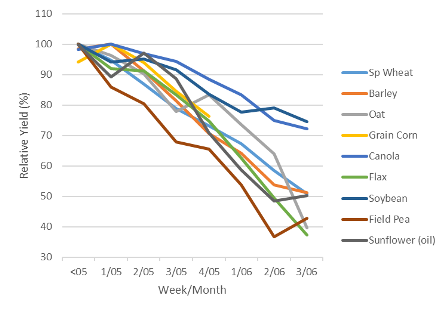Reward Versus Risk: Seeding Early In Manitoba
An early spring invariably results in early seeding. But what is early? It is not unusual for farmers to seed in April when there is an early snow melt, minimal run-off and above normal temperatures. But early could also be first week of May, if air and soil tempertures are still not reaching 10C as daytime highs and below zero over night.
The Rewards: Increased Yields & Quality
Perhaps the biggest driver for early seeding is the potential for higher yields. The majority of seeding date research conducted in Western Canada, reports increased yields with early seeding. Farmer reported data in Manitoba to Manitoba Agricultural Services Corporation (MASC) also shows that earlier seeding dates generally result in higher yields. Figure 1 shows the average relative yield of various crops as seeding date moves from late April to mid June. Average relative yields were highest for spring wheat, oat, flax, soybean, field pea, and sunflower for the late April seeding date. Barley, grain corn, and canola yields were highest on average when seeded the first week of May. It is important to keep in mind that the data presented is for final crop in the ground.

Figure 1: Average relative yields reported to MASC during each sowing week for selected crops grown in Manitoba for the period of 2010-2019. The vertical axis represents the percentage of average yield, and the horizontal axis represents the week each crop is sown. Source: Manitoba Agricultural Services Corporation Seeded Acreage Report.
Why do we see increased yield potential as a result of earlier seeding? Several factors can contribute to this increase:
- Moisture - will better utilize available soil moisture throughout the growing season.
- Weed Competition - enables faster crop establishment and increased competition versus weeds.
- Insect or Disease Damage - can be potentially reduced if crop is not at the susceptible stage when insects arrive or ideal weather conditions exist. For example, wheat is only susceptible to attack by wheat midge between heading and flowering. Adult wheat midge typically emerges in late June or early July. With early seeding, the crop may head/flower before peak populations occur. For more information on insects relevant to Manitoba crop production, please refer to Manitoba Agriculture and Resource Development's Insect webpages and Plant Diseases webpages.
- Heat Damage at Flowering Onset - crop development is driven by accumulation of heat and moisture, if a crop can flower/head earlier than when peak high temperatures occur in mid-July, yield reductions can be avoided.
- Better Harvest Conditions - early seeding usually translates into early maturity and harvest. In most years, weather conditions in August and into September are drier and more favourable for harvest, also fall frost could be avoided that can cause yield and quality reductions.
- Reduced Lodging - later planted crops tend to be taller (as a result of increased internode length) and therefore may be more prone to lodging.
The Risks: Cold Soil Temperatures & Frost Damage
One potential risk with early seeding is soil temperatures can be below the minimum needed for germination. THis can result in delayed germination and uneven or inadequate emergence. The table below shows minimum germination temperatures for several crops. These values should be regarded as approximate since germination depends on several factors.
To measure soil temperature place your soil thermometer at the target seeding depth. Take a measurement in the morning and evening to determine an average for the day. It is recommended to take readings over a few days to determine a multiple day average and to measure temperature in a number of locations in the field.
Table 1: Minimum average soil temperature for germination for various crops
| Crop | Temperature (°C) |
|---|---|
| Wheat | 4 |
| Barley | 4 |
| Oats | 4 |
| Corn | 10 |
| Canola | 5 |
| Flax | 9 |
| Sunflower | 6 |
| Edible Beans | 10 |
| Peas | 5 |
| Soybeans | 10 |
Sources: North Dakota State University Extension Service, Alberta Agriculture and Forestry, and Canola Council of Canada.
Another potential risk with early seeding is injury from spring frost. Impact of freezing temperatures will depend on temperature, length of time sub-zero temperatures occur, soil moisture levels, plant residue levels, the following daytime temperatures, and the plant's growth stage. Different crops also have varying tolerance levels to freezing temperatures, usually dependent on crop stage.
For more detailed information on the basics of frost damage, crop tolerance to freezing temperatures, the hardening off process, etc. please refer to Manitoba Agriculture's Spring Frost Damage Bulletin.
Final Notes
When presented with the opportunity, farmers will seize the chance to get an early start to seeding. It is hard to argue knowing that early seeding favors higher yields; but remember, early seeding does not always guarantee higher yields or seed quality at harvest. While important, seeding date is only one of many yield-influencing factors.

